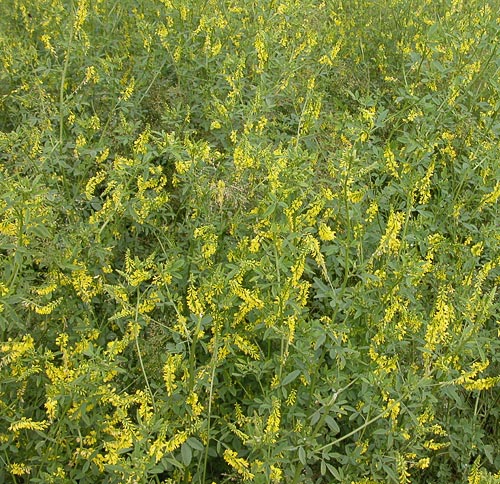Relatives
Melilotus officinalis (L.) Pall. - Yellow sweet clover, yellow melilot
Taxonomic position.
Family Leguminosae Endl., genus Melilotus Mill.Biology and morphology.
This is an erect or ascending biennial herb, up to 1.5 m tall, with trifoliate leaves. Leaflets are obovate, dentate in upper third and with terminal leaflet on petiole longer than lateral leaflets. This species has a single, well-branched stem during the first year of its growth, but, in the following years, several stems originate from crown buds. The succulent stems become fibrous with age. This plant is deeply tap-rooted. It undergoes considerable root enlargement, together with short rhizomes initiated from the plant crown, which takes place in autumn of the first year of growth. Inflorescences are elongated, one-sided racemes (4.0-10.0 cm long) of yellow flowers, 4-5 mm across, borne on long, axillary stalks (30-70 flowers per raceme). Seed pod has a reticulated, ridged coat that turns black with ripening and contains a single or pair of smooth, kidney-shaped seeds, approximately 2 mm long, brownish yellow to brown in color. This species has indeterminate flowering. Blossoms in June-September; seeds ripen in July-October. Cross-pollinated mainly by honey bees. Chromosome number: 2n=16.Distribution.
This species is distributed throughout the European part of the former USSR, the Crimea, the Caucasus, Western and Eastern Siberia, Kazakhstan and Middle Asia.Ecology.
Grows in steppe meadows, along rivers, among bushes, along roads, along railways, in fields and in ruderal places. Plants are winter hardy and productive, especially in fertile, well-drained clay and clay-loam soils. It can also be grown successfully in sandy loams and heavy, clay loams. It grows best in neutral or alkaline soils and is one of the best legumes to grow in highly alkaline soils. It is very sensitive to acidic soils, and growth is severely limited when soil pH is below 6.0. Although it tolerates a few days of flooding before growth begins in the spring, it cannot endure flooding during the growing season. Like alfalfa, it is intolerant of waterlogged soil and poor internal soil drainage.Utilization and economic value.
As compared to white-flowered Melilotus albus, the yellow-flowered sweet clover is finer stemmed, matures earlier and is more tolerant to drought. It has a high nutritive value during the vegetative stage of growth when grazed, at the pre-flowering stage for silage, and during the early-flowering stage for hay. The high coumarin content of sweet clover makes it less palatable to livestock than many other legumes. However, low-coumarin varieties are now available. Bloating can be a problem when grazing sweet clover, although it is less common than with alfalfa or true clovers. Scouring may also occur, especially when growth is young and succulent. If the animals have access to dry roughage, both conditions will be reduced. Sweet clover is one of the best legumes for soil improvement. The widely branched, deeply penetrating taproots open up the subsoil. The roots use nutrients not available to plants with shallow roots. When sweet clover plants decay, the nutrients in the roots are released for use by other crops. Sweet clover is an excellent source of nectar and pollen for honey bees.Reference citations:
Brezhnev D.D., Korovina O.N. 1980. Wild relatives of the cultivated plants of flora of the USSR. Leningrad: Kolos. 376 pp. (In Russian)Galushko A.I. 1980. Flora of Northern Caucasus. A field guide. Vol. 2. Rostov-na-Donu. 350 pp. (In Russian)
Grossheim A.A. 1945. Genus Melilotus. Flora of the USSR. Vol. 11. Moscow-Leningrad: USSR. 176-189 p. (In Russian)
Grossheim A.A. 1952. Genus Melilotus. Flora of the Caucasus. Vol. 5. Moscow-Leningrad: Academy of Science of the USSR. 192-194 p. (In Russian)
Hulten E., Fries M. 1986. Atlas of North European Vascular Plants North of the Tropic of Cancer. Vol. 1-3. Konigstein. 1172 p.
Ovchinnikov P.N., ed. 1978. Flora of Tajikistan. Vol. 5. Leningrad: Nauka. 678 pp. (In Russian)
Pavlov N.B., ed. 1961. Flora of Kazakhstan. Vol. 5. Alma-Ata: AN KazSSR. 515 pp. (In Russian)
Phyodorov A.A., ed. 1987. Flora of the European part of the USSR. Vol. 6. 254 pp. (In Russian)
Polozhiy A.B., Malyshev L.I., eds. 1994. Flora of Siberia. Vol. 9. Novosibirsk: Nauka. 280 pp. (In Russian)
Schischkin V.K., Bobrov E.G., eds. 1945. Flora of the USSR. Vol. 11. Moscow-Leningrad: USSR. 129-176 p. (In Russian)
Schmidt V.M., ed. 1983. Areas of medical plants and their relatives of the USSR. Leningrad: Leningrad University Publishers. 340 pp.
Suvorov V.V. 1950. Genus Melilotus. Flora of cultivated plants of the USSR. Vol. 13. Moscow-Leningrad. Issue 1. 345-502 p. (In Russian)
Vvedenskiy A.I., ed. 1981. Plants of Asia Minor. A field guide. Vol. 6. Tashkent: Fan. 394 pp. (In Russian)


